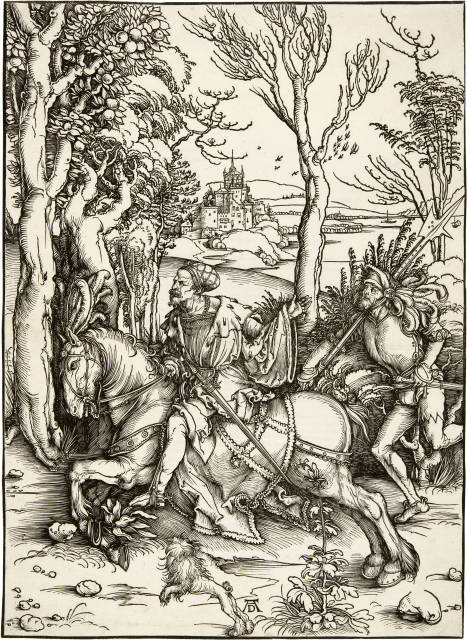- EN
Log in
- Live Auctions
- Past auctions
- More
- Gallery
- Art Dealing
- Publishing
- Kornfeld today
- The Story of Kornfeld
- Information




Sale time 12-09-2024,
about 19:10 h (CET)
(+/- 30 min)
Circa 1496
Woodcut on laid paper with watermark "Large Imperial Orb" (Meder watermark 53)
38.8x28.2 cm, sheet size
Schoch/Mende/Scherbaum 106
Meder 265/I (of II/d)
Collection Johann Andreas Boerner (1785-1862), Nuremberg, Lugt 269, his collection auctioned at
Auction Weigel, Leipzig, 17 October 1864, lot 714
Collection Ralf Leopold von Retberg (1812-1885), Munich, Lugt 2822, his collection auctioned at
Auction Amsler and Ruthardt, Berlin, from 4 March 1886, lot 36, catalogued as follows: "Magnificent impression of the sharpness of a pen drawing, on paper with the imperial orb"
Private collection
Auction Galerie Kornfeld, Bern, 16 June 2017, lot 17
The Eberhard W. Kornfeld Collection, Bern, Lugt 913b
Brilliant impression of this important early main sheet. In excellent condition, with the fully visible borderline on all sides
The present print shows a horseman, followed by a lansquenet, in a wooded landscape with a view of a rich castle on the shore of a lake. The horseman, armed with a sword and sitting on a richly decorated saddlecloth, is accompanied by a lansquenet carrying a halberd and sword without breastplate or leg armour; he follows the horseman at a running pace. This idealised scene from knightly life towards the end of the 15th century is the most important and largest non-religious woodcut in Dürer's artistic production before 1500.
Together with the illustrations of the "Apocalypse", the seven early single-sheet woodcuts, which in addition to this sheet also include "The Torture of the Ten Thousand", "Hercules Kills the Molionides", "The Men's Bath", "The Holy Family with the Hare", "Samson with the Lion" and "The Torture of St Catherine", form the centrepiece of Dürer's early graphic production, with which he opened a new chapter in the history of the woodcut in terms of visual language and format.
Um 1496
Holzschnitt auf Bütten mit Wasserzeichen "Grosser Reichsapfel" (Meder Wasserzeichen 53)
38,8x28,2 cm, Blattgrösse
Schoch/Mende/Scherbaum 106
Meder 265/I (v. II/d)
Slg. Johann Andreas Boerner (1785-1862), Nürnberg, Lugt 269. Seine Sammlung versteigert bei
Auktion Weigel, Leipzig, 17. Oktober 1864, Los 714
Slg. Ralf Leopold von Retberg (1812-1885), München, Lugt 2822. Seine Sammlung versteigert bei
Auktion Amsler und Ruthardt, Berlin, ab 4. März 1886, Los 36. Wie folgt katalogisiert: "Prachtvoller Abdruck von der Schärfe einer Federzeichnung, auf Papier mit dem Reichsapfel"
Privatsammlung
Auktion Galerie Kornfeld, Bern, 16. Juni 2017, Los 17
Slg. Eberhard W. Kornfeld, Bern, Lugt 913b
Brillanter Druck dieses wichtigen frühen Hauptblatts. In ausgezeichneter Erhaltung, umlaufend mit der voll sichtbaren Einfassungslinie
Das vorliegende Blatt zeigt einen Reiter, gefolgt von einem Landsknecht, in einer bewaldeten Landschaft mit Ausblick auf eine reiche Burg am Ufer eines Sees. Der mit einem Schwert bewaffnete Reiter, der auf einer reich verzierten Schabracke sitzt, wird von einem Hellebarde und Schwert tragenden Landsknecht ohne Brust- und Beinpanzer begleitet; er folgt dem Reiter im Laufschritt. Diese sicherlich idealisierte Szene aus dem Ritterleben gegen Ende des 15. Jahrhunderts ist der bedeutendste und grösste nicht-religiöse Holzschnitt in Dürers Kunstproduktion vor 1500.
Die insgesamt sieben frühen Einblattholzschnitte, zu dem neben diesem Blatt noch "Die Marter der Zehntausend", "Herkules tötet die Molionides", "Das Männerbad", "Die Heilige Familie mit dem Hasen", "Samson mit dem Löwen" sowie "Die Marter der heiligen Katharina" zählen, formen gemeinsam mit den Illustrationen der "Apokalypse" das Kernstück der frühen Graphikproduktion Dürers, mit der er ein in Bildsprache und Format neues Kapitel in der Geschichte des Holzschnitts aufschlägt.
| Switzerland | CHF | 130 |
| Europe | CHF | 230 |
| Overseas | CHF | 290 |





